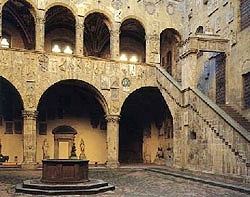Bargello Biography
The Bargello Museum has a remarkable collection of Renaissance sculpture and works of art. Located in the impressive Palazzo del Bargello, a fortress with powerful embattlements which surround the austere facade. Begun in 1255, the building was the headquarters of the Capitano del Popolo and later of the Podestà and Council of Justice. In 1574, it became the living quarters for the Captain of Justice (chief of police) and was used as a prison. Despite a series of alterations and additions which altered the original plan during the 14th and 15th centuries, the palace preserved its pleasant severity, best seen in the beautiful courtyard, the balcony and the large hall on the first floor. A covered staircase, built in the 14th century, leads to an upper loggia. The walls of the courtyard are covered with dozens of coats of arms of the various Podestà and Giudici di Ruota (judges).
Since 1859, the building houses the Museo Nazionale which brings together many important Renaissance sculptures and masterpieces of the minor arts from varying periods, including masterpieces by Donatello, Luca della Robbia, Verrocchio, Michelangelo and Cellini. The museum was subsequently enriched with splendid collections of bronzes, majolica, waxes, enamels, medals, seals, ivories, amber, tapestries, furniture and textiles from the Medici collections and those of private donors. For Renaissance art lovers, the Bargello is to sculpture what the Uffizi is to painting.
The Bargello Museum has a remarkable collection of Renaissance sculpture and works of art. Located in the impressive Palazzo del Bargello, a fortress with powerful embattlements which surround the austere facade. Begun in 1255, the building was the headquarters of the Capitano del Popolo and later of the Podestà and Council of Justice. In 1574, it became the living quarters for the Captain of Justice (chief of police) and was used as a prison. Despite a series of alterations and additions which altered the original plan during the 14th and 15th centuries, the palace preserved its pleasant severity, best seen in the beautiful courtyard, the balcony and the large hall on the first floor. A covered staircase, built in the 14th century, leads to an upper loggia. The walls of the courtyard are covered with dozens of coats of arms of the various Podestà and Giudici di Ruota (judges).
Since 1859, the building houses the Museo Nazionale which brings together many important Renaissance sculptures and masterpieces of the minor arts from varying periods, including masterpieces by Donatello, Luca della Robbia, Verrocchio, Michelangelo and Cellini. The museum was subsequently enriched with splendid collections of bronzes, majolica, waxes, enamels, medals, seals, ivories, amber, tapestries, furniture and textiles from the Medici collections and those of private donors. For Renaissance art lovers, the Bargello is to sculpture what the Uffizi is to painting.
Bargello
Bargello
Bargello
Bargello
Bargello
Bargello
Bargello
Bargello
Bargello technique
Bargello Quilts by Becbo









No comments:
Post a Comment